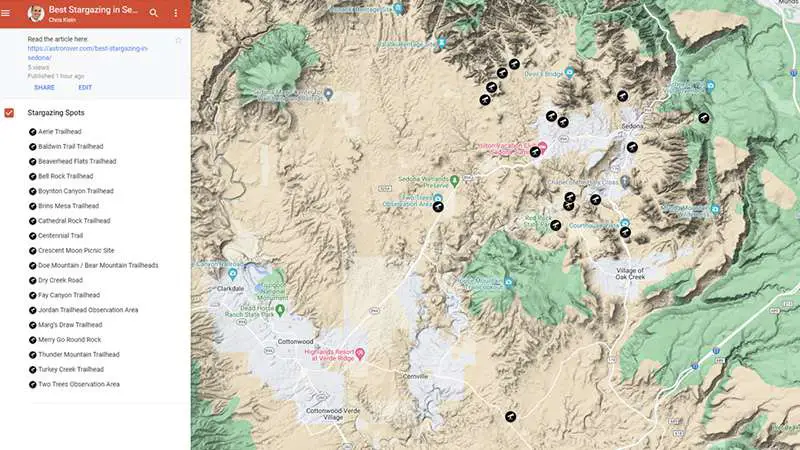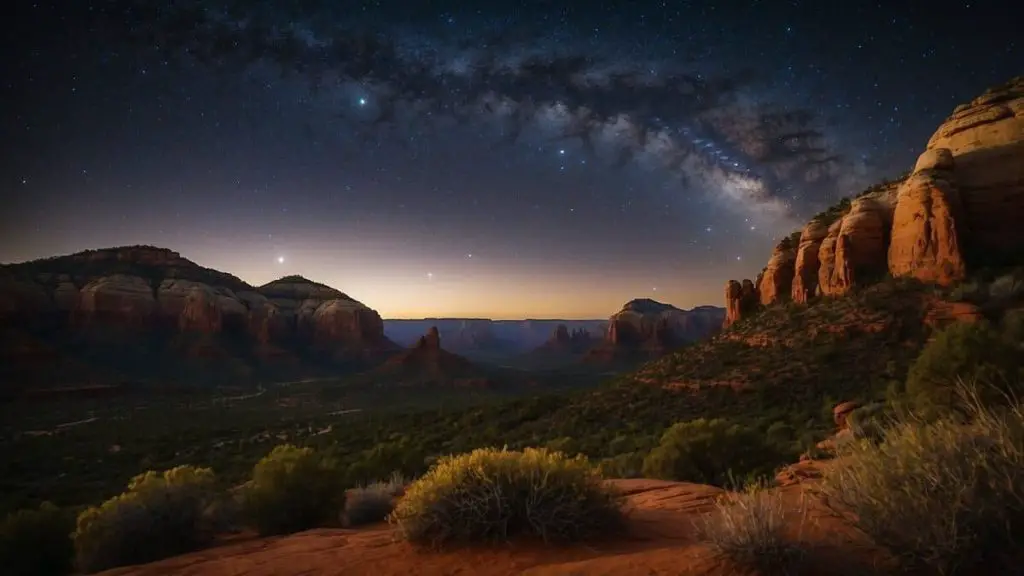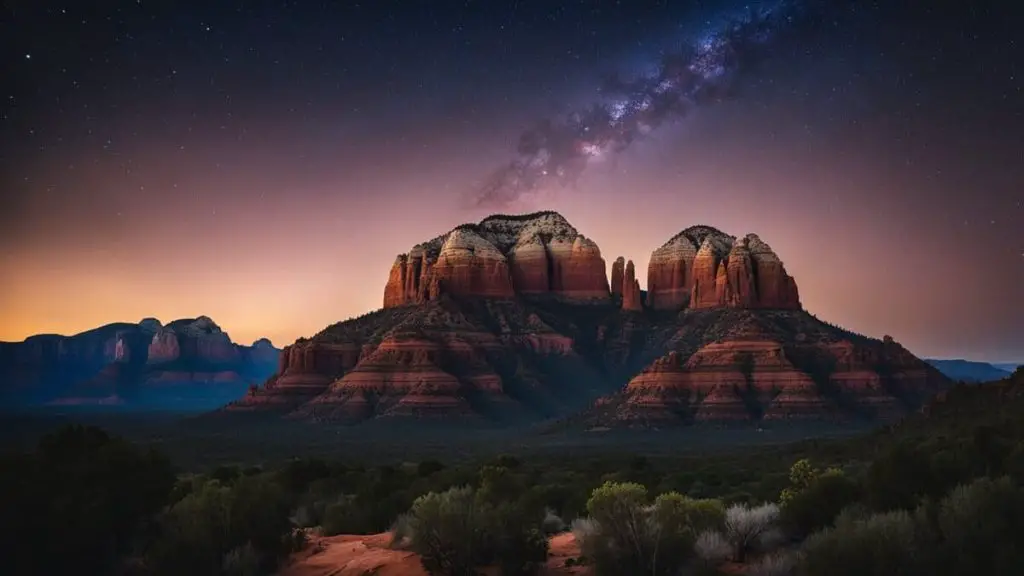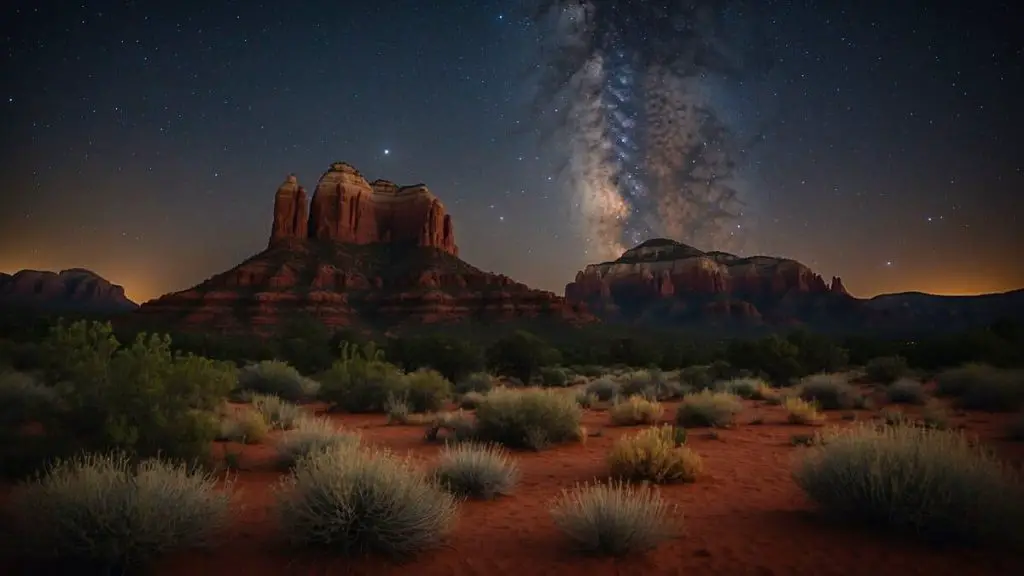You’re drawn to the Two Trees Observing Area for its renowned stargazing near Sedona, AZ. It’s accessible and promises an unparalleled view of the night sky.
However, without proper planning and knowledge, you might miss the optimal conditions or forget essential gear, detracting from the experience.
This article equips you with everything needed for a successful stargazing trip: the best times to go, what to bring, and how to preserve the pristine dark skies. Get ready for an unforgettable celestial adventure.
Key Things to Know
- Two Trees Observing Area offers prime stargazing with minimal light pollution under Bortle Class 3 skies.
- Aim for clear, moonless nights and avoid monsoon season (July-September).
- Bring your telescopes or binoculars and a red-light flashlight.
- Sedona’s Dark Sky Community status enhances your night sky viewing experience.
Recommended For You
Overview of Two Trees Observing Area

Two Trees Observing Area is my go-to spot for stargazing near Sedona, AZ. You can easily reach it off State Highway 89A and Dry Creek Road.
For a complete list, read my article about the top stargazing spots in Sedona.

Location and Access
Two Trees Observing Area sits strategically off State Highway 89A near the Dry Creek Road intersection. It’s an accessible field that’s popular among star enthusiasts.
To get there:
- I often start my journey from Sedona, AZ.
- Drive towards Dry Creek Road.
- Follow the signs leading to the observing area.
Facilities and Amenities
I’ve always found the Two Trees Observing Area a simple yet welcoming haven for night sky admirers like myself. Although the amenities are minimal, the clear skies make up for it.
Here’s what I love:
- There’s plenty of open space for setting up my telescope or laying back for an unobstructed view of the stars.
- Easy parking access, allowing you to start stargazing shortly after arrival.
Remember to bring your equipment, as there are no rentals available on-site.
Stargazing in Sedona

Sedona is a stellar place for looking up at the night sky. Here, you can see twinkling stars and the Milky Way with minimal effort due to the dark and clear skies.
To get the most out of my stargazing experiences in Sedona, I always aim for nights when the sky is clear and the moon is not too bright.
FREE STARGAZING CHECKLIST
My 5-page Stargazing Checklist will enhance your astronomical observations.
Follow this free checklist to navigate the night sky with confidence, clarity, and a sense of preparedness for a rewarding stargazing experience.

Optimal Conditions for Stargazing
To get the most out of your stargazing experience in Sedona, aim for nights when the sky is clear and the moon is not too bright.
Here are the best conditions for you:
- Monsoon Season: Avoid, as it brings cloudy skies from July to September.
- Light Pollution: Minimal in Sedona, thanks to the International Dark Sky Association identifying the area as a dark sky community.
Key Astronomical Features
You’re in for a treat when you look up at Sedona’s night sky.
Here’s what you can expect to see:
- Milky Way: Visible in the summer, with a wide band of stars across the sky.
- Constellations: Year-round visibility due to clear skies, perfect for constellation spotting.
Local Stargazing Events
Join in on the fun with events that bring the cosmos closer to you:
- Sirius Lookers: This group hosts stargazing gatherings. Keep an eye on their upcoming events.
- Regular events: Check local listings for nights dedicated to observing the stars.
Sedona Dark Skies Initiative

The Dark Skies Initiative is about keeping our night skies free from light pollution so you can enjoy stellar views.
Sedona’s Dark Sky Community
Having witnessed Sedona’s night sky, I understand why it has earned the title of a Dark Sky Community. Its commitment to preserving the night sky is evident in the unparalleled visibility of stars and planets.
Here’s what makes it special:
- Recognition by the International Dark-Sky Association: Sedona is one of only a few spots recognized for its clear, dark skies.
- Commitment to Dark Skies: The community takes pride in reducing light pollution, ensuring stars and planets shine brightly for your stargazing.
Lighting Regulations and Preservation
To keep the sky dark, rules are in place:
- Outdoor Lighting Codes: I’ve noticed these codes help keep city lights dim, making my night sky view vivid.
- Protection of Nighttime Environment: Lights must be night-sky friendly, meaning less glare and more starlight.
By following these guidelines, Sedona ensures that places like the Two Trees Observing Area stay perfect for your stargazing adventures.
Exploring Surrounding Attractions in Sedona

Around Two Trees Observing Area, you can dive into nature and culture. You’ll find everything from scenic trails to art displays.
Hiking and Trails
Nature surrounds you in Sedona, home to the iconic Red Rocks. From my numerous hikes here, I can attest it’s a dream come true for nature lovers.
- Thunder Mountain Trailhead: Start your adventure here for memorable views.
- Sedona Star Gazing: After a day hike, return for a starry night sky.
- Jordan Trailhead Observing Area: Perhaps the best place for stargazing in Sedona.
Cultural Experiences
Sedona isn’t just for nature lovers. You’ll be amazed by the art and culture here in Arizona.
- Discover local art galleries showcasing unique pieces.
- Experience the culture by visiting historic sites and attending cultural events.
Two Trees Observation Area: Practical Information for Visitors

A little preparation goes a long way when planning to visit the Two Trees Observing Area for a night under the stars.
Here’s what you need to know to make the most of your stargazing experience:
- Getting There: The Observing Area is off State Highway 89A. Look for the intersection of Forest Road 525A and Forest Road 761B. A car is necessary to travel here, as the area is remote.
- Best Times: The time of year affects what you’ll see in the sky, so check an astronomy calendar. Aim for a new moon night and arrive at sunset to get the complete darkness.
- Telescope: If you have one, it’s great to bring it along. No telescope? Binoculars can also give you a closer look at the stars.
- Flashlight: Bring one, but keep it dim. Better yet, use a red light to protect your night vision.
- Warm Clothes: Even if the days are hot, the desert cools off quickly after dark.
Tech Tips:
- Cell Phone: Your phone won’t have much service, so download maps beforehand.
- Stargazing Apps: They can help identify constellations and planets. Download before you arrive.
This spot is loved by locals like the Sirius Lookers, Sedona’s astronomy club. Follow their lead and respect the dark sky. Happy stargazing!
Best Practices for Sedona Astrotourism

When you head out for a night under the stars, it’s essential to prepare.
Here’s how you can ensure a stellar astrotourism experience:
- Plan Your Travel: Always check the weather in Sedona and aim for clear, moonless nights. This gives you the best chance to see the stars. Personal experience has taught me that this planning pays off with spectacular views.
- Choose the Right Spot: Two Trees Observing Area is a popular stargazing spot in Sedona. It offers excellent views with little light pollution.
Pack Smart:
- Bring a flashlight, but cover it with red cellophane. This helps you see without ruining your night vision.
- Binoculars are great for a close-up of the night sky. They’re also easier to carry than telescopes.
While Stargazing:
- Give your eyes time to adjust to the dark. It can take about 30 minutes.
- Stay put in one spot to enjoy the experience. This helps you relax and see more.
Respect the Space:
- Use soft lighting if necessary. Avoid bright light fixtures that can affect both your view and that of others.
- Keep noise to a minimum to create a peaceful atmosphere for everyone.
Remember:
- Dress warmly. Nights can get cold, even in Sedona.
- Leave no trace. Keep the area clean for the next group of star enthusiasts.
Following these tips will maximize your enjoyment of the Sedona night skies. Happy stargazing!
Frequently Asked Questions
Can I participate in stargazing events if I don’t have my telescope?
Yes, you can participate in stargazing events even without your telescope. Many events hosted by local astronomy clubs like Sirius Lookers provide telescopes for public use, allowing everyone to enjoy the night sky.
What should I do if the weather suddenly changes during my stargazing trip?
If the weather changes unexpectedly during your stargazing trip, seek shelter and wait it out. Weather can be unpredictable, but clear skies often return quickly in Sedona, offering more opportunities for observation.
Are there any recommended apps to enhance my stargazing experience at Two Trees Observing Area?
Several stargazing apps can enhance your experience at Two Trees Observing Area by helping you identify constellations, planets, and stars. Apps like Star Walk, SkyView, and Stellarium are highly recommended for beginners and seasoned astronomers to navigate the night sky.
TL;DR
- Two Trees Observing Area near Sedona, AZ, is an accessible and prime spot for stargazing with minimal light pollution.
- Best viewing times are clear, moonless nights, avoiding the monsoon season from July to September.
- Visitors should bring their stargazing equipment, like telescopes or binoculars, and use red-light flashlights to preserve night vision.
- Due to strict light pollution controls, Sedona’s status as a Dark Sky Community ensures exceptional celestial viewing conditions.
- Local stargazing events and apps can enhance the experience, with resources available for novice and expert astronomers.
Your curiosity fuels our exploration of the night sky! While I share my stargazing adventures and knowledge, I know there’s always more to learn and discover together.
Do you have a question or a unique observation? I’d love to hear from you.
Please share your thoughts and questions in the comments below, and let’s continue this celestial journey together.




